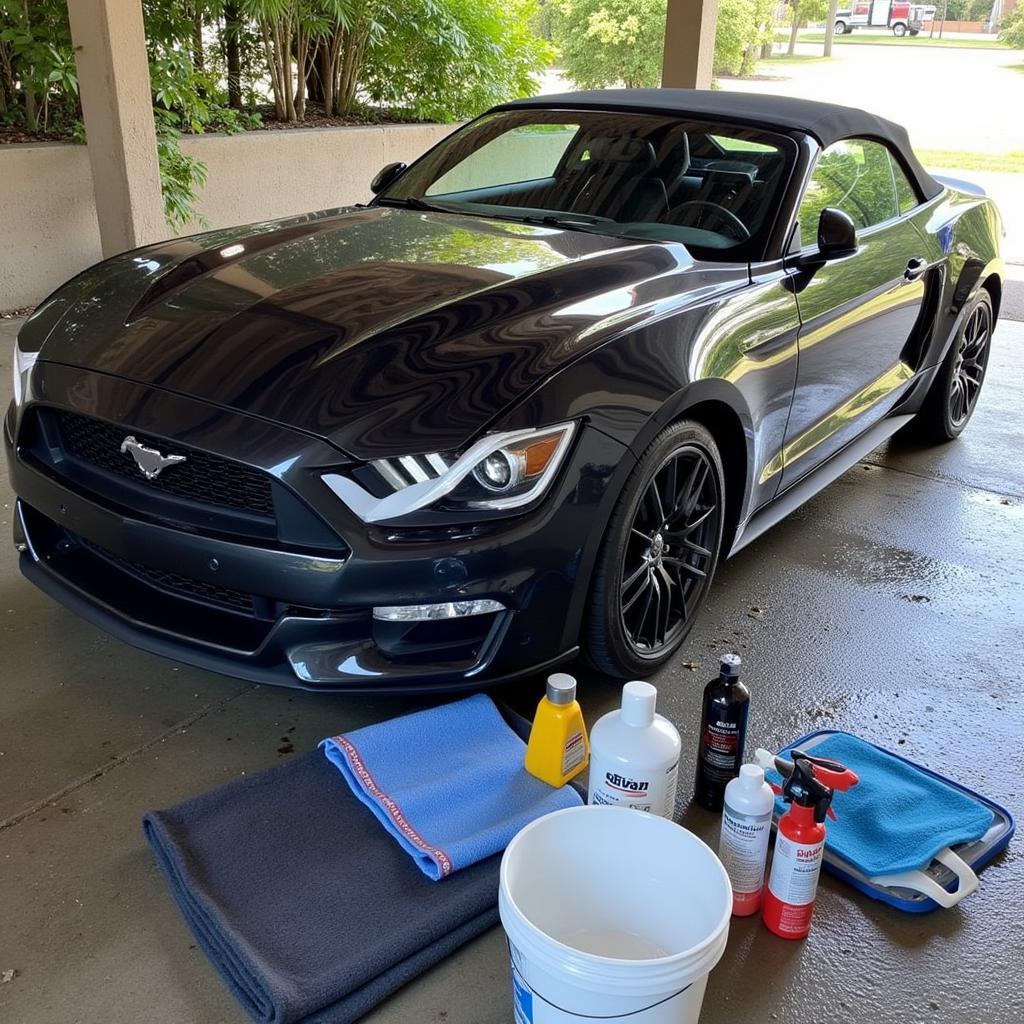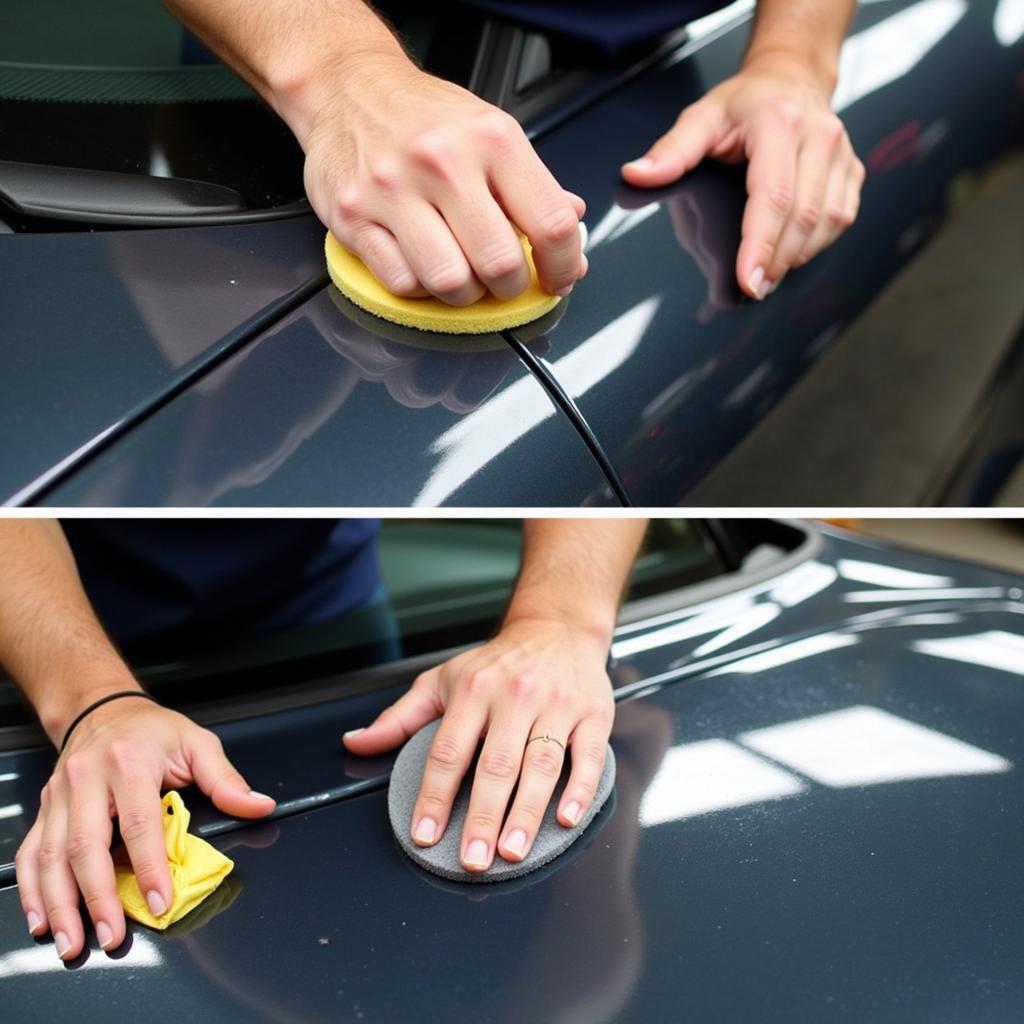Detailing your sports car isn’t just about a clean finish; it’s about preserving its value, enhancing its performance, and showcasing its inherent beauty. Whether you’re preparing for a concours d’elegance or simply want your weekend warrior to shine, this guide will provide you with the expertise to detail your sports car like a pro.
Knowing how to draw a car in detail can be surprisingly helpful when it comes to understanding the contours and lines of your sports car, which is crucial for proper detailing. This understanding allows for more precise application of products and ensures every nook and cranny receives the attention it deserves. A well-detailed sports car is more than just clean; it’s a testament to the owner’s passion and dedication. From the meticulous cleaning process to the final protective layers, every step contributes to the overall presentation and longevity of the vehicle.
 Sports Car Wash Preparation
Sports Car Wash Preparation
Washing Your Sports Car: The Foundation of Detailing
The first step in any detailing process is a thorough wash. However, with a sports car, this requires extra care. Use a pH-neutral car wash soap specifically designed for automotive paint. Avoid harsh detergents that can strip away waxes and sealants. Employ the two-bucket method – one with soapy water and the other with clean rinse water – to minimize the risk of swirling and scratching. A quality wash mitt is essential for gently lifting dirt and grime without damaging the paint.
Why pH-Neutral Soap Matters
pH-neutral soaps are crucial for maintaining the integrity of your car’s paintwork. They are gentle enough to prevent stripping away protective layers, yet effective in removing dirt and grime. Using the wrong soap can lead to premature fading and dulling of the paint, diminishing the overall appearance of your sports car.
What are the best tools for washing a sports car? High-quality microfiber wash mitts and drying towels are essential. These materials are gentle on the paint and highly effective at absorbing water and dirt. A grit guard in your wash bucket also helps to trap dirt particles, preventing them from being reapplied to the car’s surface.
Paint Correction: Achieving Flawless Perfection
After washing and drying, inspect the paint for imperfections like swirl marks, scratches, and chips. Paint correction involves removing these imperfections to restore the paint’s original clarity and shine. This process often involves using a clay bar to remove embedded contaminants followed by polishing compounds and a dual-action polisher. Is car detailing tax deductible? In some cases, it can be, especially if the detailing is part of maintaining a business vehicle. You can check out our article on is car detailing tax deductible for more information.
Understanding Paint Correction Techniques
Paint correction can range from minor touch-ups to full-scale restoration. Choosing the right technique depends on the severity of the imperfections and the desired outcome. For minor swirl marks, a light polish might suffice. Deeper scratches and chips may require more aggressive compounding and wet sanding.
“Precision is key in paint correction,” says renowned detailing expert, James P. Carter. “A thorough understanding of the paint’s condition and the appropriate techniques is crucial for achieving a flawless finish.”
Protecting Your Investment: Applying Sealants and Waxes
Once the paint is corrected, it’s crucial to protect it from the elements. Sealants and waxes provide a protective barrier against UV rays, environmental contaminants, and minor scratches. Sealants offer longer-lasting protection, while waxes provide a deeper, richer shine. How long does an interior car detail take? While it depends on the level of detail, you can learn more about the time involved by reading our article on how long does an interior car detail take.
Choosing the Right Protection
Selecting the right sealant or wax depends on your personal preferences and the environment your car is exposed to. For those seeking long-lasting protection, a ceramic coating is an excellent option. For a more traditional approach, carnauba wax offers a warm, glossy finish.
 Applying Car Wax to Sports Car
Applying Car Wax to Sports Car
Interior Detailing: The Finishing Touch
Detailing the interior of your sports car is just as important as the exterior. This involves thoroughly cleaning and conditioning all surfaces, including leather, vinyl, plastic, and carpet. Use specialized cleaners and conditioners designed for each material.
“A clean and well-maintained interior enhances the driving experience and contributes to the overall value of the vehicle,” adds Carter. “Don’t neglect the details.” Looking for tips on detailing cars in a virtual environment? Our guide on how to make detailed cars in roblox might offer some interesting parallels. And if you’re interested in capturing the beauty of your detailed car on paper, check out our article on how to draw a car in detail. Perhaps you’re a collector of diecast models and are seeking more information about specific models? We’ve got you covered with our guide on how to get detailed information about yatming collectable cars.
Conclusion
Detailing your sports car is a rewarding process that not only enhances its appearance but also protects your investment. By following these steps and using the right products, you can keep your sports car looking its best for years to come.
FAQ
- How often should I detail my sports car?
- What are the essential tools for detailing a sports car?
- What’s the difference between a sealant and a wax?
- How can I remove swirl marks from my car’s paint?
- What is the best way to clean leather car seats?
- How can I protect my car’s paint from the sun?
- What are the benefits of ceramic coating?
Need help with your car detailing? Contact us via WhatsApp: +1(641)206-8880, Email: [email protected]. We have a 24/7 customer support team.

Leave a Reply